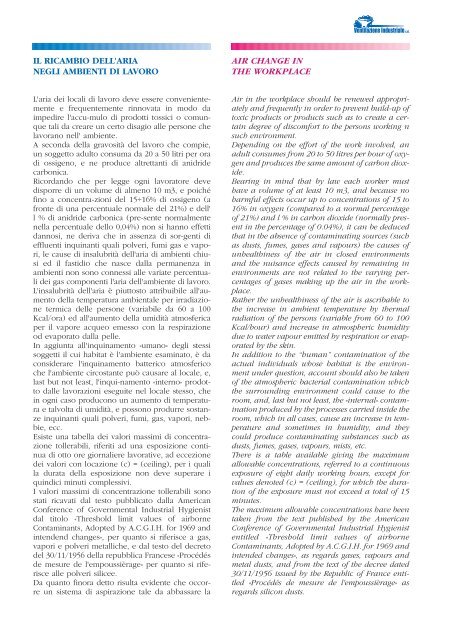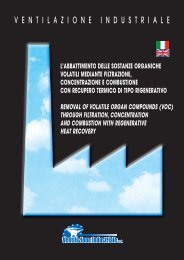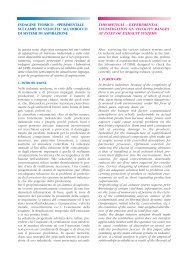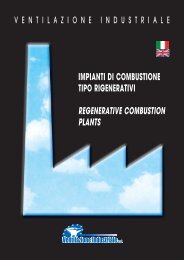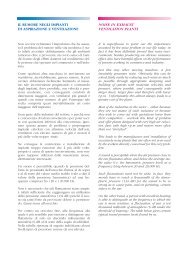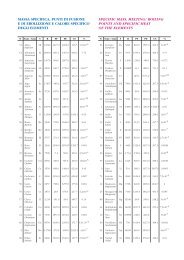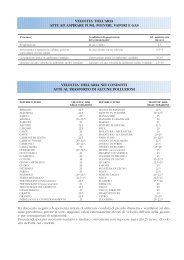Ricambio dell'aria negli ambienti di lavoro - Ventilazione Industriale
Ricambio dell'aria negli ambienti di lavoro - Ventilazione Industriale
Ricambio dell'aria negli ambienti di lavoro - Ventilazione Industriale
Create successful ePaper yourself
Turn your PDF publications into a flip-book with our unique Google optimized e-Paper software.
IL RICAMBIO DELL'ARIA<br />
NEGLI AMBIENTI DI LAVORO<br />
AIR CHANGE IN<br />
THE WORKPLACE<br />
L'aria dei locali <strong>di</strong> <strong>lavoro</strong> deve essere convenientemente<br />
e frequentemente rinnovata in modo da<br />
impe<strong>di</strong>re l'accu-mulo <strong>di</strong> prodotti tossici o comunque<br />
tali da creare un certo <strong>di</strong>sagio alle persone che<br />
lavorano nell' ambiente.<br />
A seconda della gravosità del <strong>lavoro</strong> che compie,<br />
un soggetto adulto consuma da 20 a 50 litri per ora<br />
<strong>di</strong> ossigeno, e ne produce altrettanti <strong>di</strong> anidride<br />
carbonica.<br />
Ricordando che per legge ogni lavoratore deve<br />
<strong>di</strong>sporre <strong>di</strong> un volume <strong>di</strong> almeno 10 m3, e poiché<br />
fino a concentra-zioni del 15÷16% <strong>di</strong> ossigeno (a<br />
fronte <strong>di</strong> una percentuale normale del 21%) e dell'<br />
l % <strong>di</strong> anidride carbonica (pre-sente normalmente<br />
nella percentuale dello 0,04%) non si hanno effetti<br />
dannosi, ne deriva che in assenza <strong>di</strong> sor-genti <strong>di</strong><br />
effluenti inquinanti quali polveri, fumi gas e vapori,<br />
le cause <strong>di</strong> insalubrità <strong>dell'aria</strong> <strong>di</strong> <strong>ambienti</strong> chiusi<br />
ed il fasti<strong>di</strong>o che nasce dalla permanenza in<br />
<strong>ambienti</strong> non sono connessi alle variate percentuali<br />
dei gas componenti l'aria dell'ambiente <strong>di</strong> <strong>lavoro</strong>.<br />
L'insalubrità <strong>dell'aria</strong> è piuttosto attribuibile all'aumento<br />
della temperatura ambientale per irra<strong>di</strong>azione<br />
termica delle persone (variabile da 60 a 100<br />
Kcal/ora) ed all'aumento della umi<strong>di</strong>tà atmosferica<br />
per il vapore acqueo emesso con la respirazione<br />
od evaporato dalla pelle.<br />
In aggiunta all'inquinamento «umano» degli stessi<br />
soggetti il cui habitat è l'ambiente esaminato, è da<br />
considerare l'inquinamento batterico atmosferico<br />
che l'ambiente circostante può causare al locale, e,<br />
last but not least, l'inqui-namento «interno» prodotto<br />
dalle lavorazioni eseguite nel locale stesso, che<br />
in ogni caso producono un aumento <strong>di</strong> temperatura<br />
e talvolta <strong>di</strong> umi<strong>di</strong>tà, e possono produrre sostanze<br />
inquinanti quali polveri, fumi, gas, vapori, nebbie,<br />
ecc.<br />
Esiste una tabella dei valori massimi <strong>di</strong> concentrazione<br />
tollerabili, riferiti ad una esposizione continua<br />
<strong>di</strong> otto ore giornaliere lavorative, ad eccezione<br />
dei valori con locazione (c) = (ceiling), per i quali<br />
la durata della esposizione non deve superare i<br />
quin<strong>di</strong>ci minuti complessivi.<br />
I valori massimi <strong>di</strong> concentrazione tollerabili sono<br />
stati ricavati dal testo pubblicato dalla American<br />
Conference of Governmental Industrial Hygienist<br />
dal titolo «Threshold limit values of airborne<br />
Contaminants, Adopted by A.C.G.I.H. for 1969 and<br />
intendend changes», per quanto si riferisce a gas,<br />
vapori e polveri metalliche, e dal testo del decreto<br />
del 30/11/1956 della repubblica Francese «Procédés<br />
de mesure de l'empoussièrage» per quanto si riferisce<br />
alle polveri silicee.<br />
Da quanto finora detto risulta evidente che occorre<br />
un sistema <strong>di</strong> aspirazione tale da abbassare la<br />
Air in the workplace should be renewed appropriately<br />
and frequently in order to prevent build-up of<br />
toxic products or products such as to create a certain<br />
degree of <strong>di</strong>scomfort to the persons working n<br />
such environment.<br />
Depen<strong>di</strong>ng on the effort of the work involved, an<br />
adult consumes from 20 to 50 litres per hour of oxygen<br />
and produces the same amount of carbon <strong>di</strong>oxide.<br />
Bearing in mind that by law each worker must<br />
have a volume of at least 10 m3, and because no<br />
harmful effects occur up to concentrations of 15 to<br />
16% in oxygen (compared to a normal percentage<br />
of 21%) and l % in carbon <strong>di</strong>oxide (normally present<br />
in the percentage of 0.04%), it can be deduced<br />
that in the absence of contaminating sources (such<br />
as dusts, fumes, gases and vapours) the causes of<br />
unhealthiness of the air in closed environments<br />
and the nuisance effects caused by remaining in<br />
environments are not related to the varying percentages<br />
of gases making up the air in the workplace.<br />
Rather the unhealthiness of the air is ascribable to<br />
the increase in ambient temperature by thermal<br />
ra<strong>di</strong>ation of the persons (variable from 60 to 100<br />
Kcal/hour) and increase in atmospheric humi<strong>di</strong>ty<br />
due to water vapour emitted by respiration or evaporated<br />
by the skin.<br />
In ad<strong>di</strong>tion to the “human” contamination of the<br />
actual in<strong>di</strong>viduals whose habitat is the environment<br />
under question, account should also be taken<br />
of the atmospheric bacterial contamination which<br />
the surroun<strong>di</strong>ng environment could cause to the<br />
room, and, last but not least, the «internal» contamination<br />
produced by the processes carried inside the<br />
room, which in all cases, cause an increase in temperature<br />
and sometimes in humi<strong>di</strong>ty, and they<br />
could produce contaminating substances such as<br />
dusts, fumes, gases, vapours, mists, etc.<br />
There is a table available giving the maximum<br />
allowable concentrations, referred to a continuous<br />
exposure of eight daily working hours, except for<br />
values denoted (c) = (ceiling), for which the duration<br />
of the exposure must not exceed a total of 15<br />
minutes.<br />
The maximum allowable concentrations have been<br />
taken from the text published by the American<br />
Conference of Governmental Industrial Hygienist<br />
entitled «Threshold limit values of airborne<br />
Contaminants, Adopted by A.C.G.I.H. for 1969 and<br />
intended changes», as regards gases, vapours and<br />
metal dusts, and from the text of the decree dated<br />
30/11/1956 issued by the Republic of France entitled<br />
«Procédés de mesure de l'empoussièrage» as<br />
regards silicon dusts.
percentuale delle sostanze inquinanti al <strong>di</strong> sotto dei<br />
valori massimi ammessi, ed atto inoltre a contenere<br />
entro limiti <strong>di</strong> benessere fisiologico l'aumento <strong>di</strong><br />
umi<strong>di</strong>tà e temperatura causato dalle persone e dai<br />
mezzi <strong>di</strong> <strong>lavoro</strong>.<br />
Essendo in generale insufficiente l'aereazione naturale,<br />
il rinnovamento <strong>dell'aria</strong> avviene in gran parte<br />
artificial-mente.<br />
Come regola generale vale quella <strong>di</strong> immettere aria<br />
pulita dall'esterno, in modo da provocare una lieve<br />
sovrap-pressione nell'ambiente <strong>di</strong> <strong>lavoro</strong> e <strong>di</strong><br />
impe<strong>di</strong>re la penetrazione delle polveri.<br />
Qualunque sia il mezzo adottato per il ricambio<br />
dell' aria si deve evitare che le correnti colpiscano<br />
<strong>di</strong>rettamente i lavoratori addetti a posti fissi <strong>di</strong> <strong>lavoro</strong>.<br />
Le correnti d'aria provocano infatti sui soggetti<br />
colpiti un danno <strong>di</strong>pen-dente dal raffreddamento<br />
che è <strong>di</strong>rettamente proporzionale all'umi<strong>di</strong>tà della<br />
corrente ed inversamente proporzio-nale alla sua<br />
temperatura.<br />
E consigliabile perciò che la velocità <strong>dell'aria</strong> <strong>di</strong>retta<br />
verso le persone non superi 0,50 m/sec., tenendo<br />
presente che soggetti particolarmente sensibili<br />
hanno sensazioni <strong>di</strong> fasti<strong>di</strong>o anche per valori <strong>di</strong><br />
spostamento d'aria appena percettibili.<br />
Occorre inoltre ricordare che è sempre preferibile<br />
un ambiente leggermente fresco con aria frequentemente<br />
rinno-vata ad uno più caldo con aria ferma<br />
e viziata.<br />
Nell'assenza <strong>di</strong> precise <strong>di</strong>sposizioni <strong>di</strong> legge in<br />
materia, alla pagina seguente riportiamo una tabella<br />
in<strong>di</strong>cativa dei ricambi d'aria consigliati per alcuni<br />
tipi <strong>di</strong> locali.<br />
From what has been stated up till now it is clear<br />
that an exhaust system is required capable of<br />
reducing the percentage of contaminating substances<br />
to under the max. allowable concentrations;<br />
such system should also be able to keep the<br />
increase in humi<strong>di</strong>ty and temperature caused by<br />
persons and work tools to within the physiological<br />
comfort limits.<br />
As natural ventilation is normally insufficient, the<br />
air is renewed mainly by artificial means.<br />
We can take as general rule that of introducing<br />
clean air from the outside in order to produce a<br />
slight overpressure in the work environment and to<br />
prevent the ingress of dusts.<br />
Whatever means is adopted for the air change,<br />
measures must be taken to avoid draughts from<br />
<strong>di</strong>rectly hitting the workers in the fixed workplaces.<br />
In fact the air currents cause damage to the in<strong>di</strong>vidual<br />
affected, depen<strong>di</strong>ng on the cooling which is<br />
<strong>di</strong>rectly proportional to the moisture in the air current<br />
and inversely proportio-nal to its temperature.<br />
Hence it is advisable for the air velocity <strong>di</strong>rected<br />
towards persons not to exceed 0.50 m/sec., bearing<br />
in mind that especially sensitive persons feel nuisance<br />
effects also for barely perceptible air movements.<br />
It should also be remembered that a slightly cool<br />
environment with air frequently renewed is always<br />
preferable to a warmer one with still and stale air.<br />
In the absence of exact legislative provisions on the<br />
subject, a table is given on the following page in<strong>di</strong>cating<br />
the recommended air changes for certain<br />
types of room.


